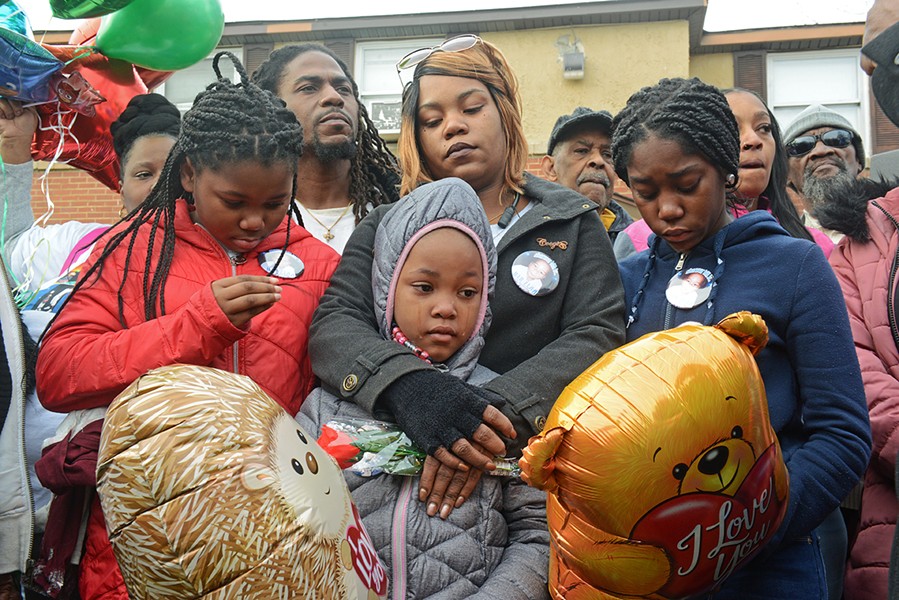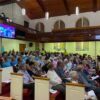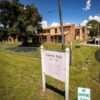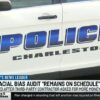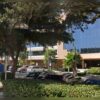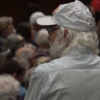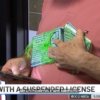By Graham Moomaw
For years, Norfolk Police Chief Larry Boone has been trying to gather data on how firearms flow from gun-store shelves to crime scenes in his city’s high-poverty neighborhoods.
Though experts and politicians have floated multiple theories about what’s driving an uptick in violence in Virginia and the rest of the country, Boone says guns are too easy to get and too hard to track as they change hands, and the COVID-19 pandemic made that problem worse.
“The gun sales soared. They soared to such a degree that now we are dealing with Armageddon,” Boone said in an interview. “We have young folks shooting young folks. And that’s the reality of it.”
Virginia’s homicide rate hit a 20-year high in 2020, and many cities are seeing higher rates of violence persist in 2021. Some of the shootings making headlines this summer have involved shockingly young victims, and the accused shooters are often teenagers themselves.
“What’s alarming to me, in the last year and a half, is the age of the shooters and the age of the victims,” Boone said. “That’s the thing that stands out the most. How brazen they are … They simply do not value life. They will pull a trigger intending to hit a specific person. But they don’t mind collateral damage either.”
When Democrats took control of the Virginia General Assembly in 2019, they wasted little time passing new gun restrictions expanding background checks, limiting handgun purchases to one per month, creating red flag orders to take guns away from people deemed dangerous, boosting penalties for leaving guns accessible to children and requiring gun owners to report lost or stolen firearms.
Gun sales spiked last year even with those new restrictions, a trend widely attributed to the uncertainty of the pandemic and civil unrest sparked by the police killing of George Floyd.
With Virginia’s homicide stats headed in the wrong direction, a coalition of gun-control groups, community activists and health providers is asking state lawmakers to devote millions in new funding to a not-particularly new idea for reducing gun crimes: focusing on deterrence within the small subset of people most likely to shoot someone or be shot.
Ahead of a special session in August when state lawmakers will decide what to do with $4.3 billion in federal relief dollars from the American Rescue Plan, the new Virginia Community Violence Coalition wants $37 million to be used to scale up community-based violence intervention programs.
The coalition’s letter ✎ EditSignasks lawmakers to prioritize what it calls an “ongoing epidemic” of violence.
“We can’t continue to fund and do things the way we’ve been doing them with very little outcome,” said Torey Edmonds, community outreach coordinator at Virginia Commonwealth University’s Clark-Hill Institute for Positive Youth Development.
Edmonds was one of 22 signatories on the letter. Other organizations involved include gun-control groups like Brady, Giffords, Everytown for Gun Safety, Moms Demand Action and the Educational Fund to Stop Gun Violence. Representatives from Sentara Healthcare and VCU Health, hospital systems that treat trauma victims in regions hit hardest by gun violence, also signed, as did community-based groups like RISC, or Richmonders Involved to Strengthen our Communities, and Friends of the Portsmouth Juvenile Court.
Community violence intervention can take many forms. Mike McLively, a Giffords attorney who leads the group’s Community Violence Initiative, says it involves identifying high-risk populations and connecting with them through street outreach, mental health services or case management.
“The idea with these interventions is in most cities, if not all in the U.S., it’s a very small percentage of people that are driving the majority of violence,” McLively said.
Violence intervention programs have been implemented in several cities and states. Operation Ceasefire, an anti-gang violence initiative implemented in Boston in the 1990s, helped reduce youth homicide statistics by more than 60 percent, earning it a reputation as a promising public-safety strategy for other urban areas.
The coalition’s letter to state lawmakers cites a 52 percent increase in intentional violent injuries treated at VCU’s Trauma Center last year.
According to crime data compiled by the Virginia State Police, murder and non-negligent manslaughter more than doubled in Portsmouth in 2020. Hampton saw a 60 percent increase, Norfolk experienced a 36 percent increase and Richmond had a 20 percent increase.
As in years past, the increase in violence has fallen heavier on some communities than others. Roughly two-thirds of the 528 victims of murder and non-negligent manslaughter in Virginia last year were Black, according to state crime data, as were a majority of offenders. Guns were involved in a vast majority of those cases.
Advocates say it should come as no surprise that communities already suffering from a lack of resources and opportunity saw longstanding problems worsen when the pandemic hit and things began to shut down.
“School can be a protective factor for our kids. It can be a nurturing environment,” Edmonds said. “Our young people got up one day and we said ‘School is closed.’ And at the drop of a dime, they shut school down for a year and a half. I am 62 years old and I have never seen that.”
Edmonds said the problem requires focusing “from all ends.”
“I think that the availability of guns is one issue. But our attitudes toward firearms is another,” Edmonds said. “Where we have a culture that … they’re in love with guns. Then we have communities where we begin to teach our young people that they always got to be ready, don’t let anybody disrespect you. And it doesn’t keep us safe.”
The first half of 2021 saw no shortage of stories illustrating the continued toll of gun violence.
In Richmond, a shootout in an apartment complex courtyard in April left a woman and her 3-month-old baby dead. Earlier this month, a 16-year-old girl was killed amid gunfire at a Henrico County shopping center, with three other teenagers, including a 15-year-old, later arrested in connection with the shooting. Another 15-year-old boy was charged in a shooting in Norfolk that injured four other juveniles, including a 6-year-old girl. In late June, two people were shot on the first night of the Salem Fair. Police announced they had taken a boy younger than 16 into custody.
“Whether you’re a Republican or a Democrat… I don’t think you want kids out there shooting each other,” said Susan Fincke, executive director of Friends of the Portsmouth Juvenile Court, a nonprofit that helps youth and families involved in the juvenile justice and child welfare systems. “So let’s collaborate in the areas where we can collaborate.”
Both Democrats and Republicans have signaled support for the strategy in the past, though one sticking point may be the role of law enforcement and whether the programs should or shouldn’t involve a heavier police presence in majority-Black neighborhoods.
Though community-based programs are backed by gun-control groups, they also align with the arguments of pro-gun Republicans who say restrictive laws on gun ownership are less effective than dedicating resources to preventing and punishing gun crimes.
House Minority Leader Todd Gilbert, R-Shenandoah, who introduced a violence intervention bill this year that failed to advance from a Democratic-controlled subcommittee, said intervention programs would “fall apart” without a strong law enforcement component to ensure there are consequences if intervention fails.
“That is not something our Democratic colleagues have an appetite for,” Gilbert said. “They are always looking to support the narrative that the guns are to blame. We believe that the guns in the hands of criminals are to blame.”
Gilbert said the broader backlash against law enforcement associated with last year’s protests against police brutality, which led Virginia Democrats to strengthen accountability measures for police without going after their budgets, is a factor in the wave of violence.
“Last year was the year that we kept being told that police were bad and criminals were victims,” Gilbert said. “I’m not saying that’s to blame. But it certainly, I believe, has contributed to that environment of lawlessness.”
Virginia Republicans have spotlighted headlines about rising violence, suggesting it’s tied to Democratic policies that make law enforcement less aggressive and the criminal justice system less punitive.
Others say that’s an oversimplification, pointing out the increase in violence last year was a nationwide trend in red and blue states alike.
Nationally, Democrats are signaling that they see the increase in shootings as a problem that requires a response. In a recent memo, President Joe Biden’s administration urged states and localities to use federal relief funding on anti-violence initiatives, including “holding rogue firearms dealers accountable for violating federal laws,” offering more resources to law enforcement and community violence intervention.
U.S. Rep. Donald McEachin, D-Richmond, recently announced he had secured almost $1 million in federal funding to assist with VCU’s anti-gun violence work.
“Gun violence has destroyed far too many lives in Richmond and disproportionately affects low-income communities and communities of color,” McEachin said in a news release.
Sen. Mamie Locke, D-Hampton, said she too is concerned about what she’s seeing in Hampton Roads and expects addressing gun violence to be a priority in the special session.
“There’s just too many guns on the streets,” Locke said.
Because of the localized nature of law enforcement, violence intervention programs can be tailored to suit the preferences of a particular community.
The new anti-violence coalition has asked the state to use $24 million to supplement $2.6 million the General Assembly budgeted for gun violence intervention earlier this year. The original $2.6 million was supposed to be directed to five localities working on anti-violence initiatives, and the proposed federal infusion could boost those grants and make them available to more local officials. Local leaders would have flexibility to decide specifics of how their program would work.
The coalition also wants $10 million to go to the Department of Criminal Justice Services to support the development of community violence prevention work through training programs, conferences and the pursuit of additional funding streams. Another $2 million is proposed to help evaluate the programs’ impact and $1 million is suggested for five new positions in DCJS.
DCJS itself requested $20 million in funding for community violence intervention in a request sent to Gov. Ralph Northam’s administration ahead of the special session.
Virginia Democrats have not yet rolled out a concrete proposal.
“Combatting community violence has been a priority of Governor Northam’s throughout his administration, and these programs are certainly a part of our discussions around federal relief funding,” said Northam spokeswoman Alena Yarmosky.
Boone, the Norfolk police chief, said community violence intervention programs can be helpful with the right people involved and the right level of commitment. But, he said, policymakers are “chasing our tail if we never impact the flow of guns.” To really make a difference, he said, there should have to be a paper trail every time a gun changes hands. (Virginia began requiring background checks on gun sales between private parties last year).
“It’s always been on the police to manage things that governments, generations ago, created,” Boone said. “In any urban setting that has poverty, it looks like Norfolk, it looks like Detroit, it looks like Richmond. It has looked that way for decades. I’m going to say it again, until we impact the flow and start tracking guns, we’ll continue to have this conversation.”
View the original story here.
